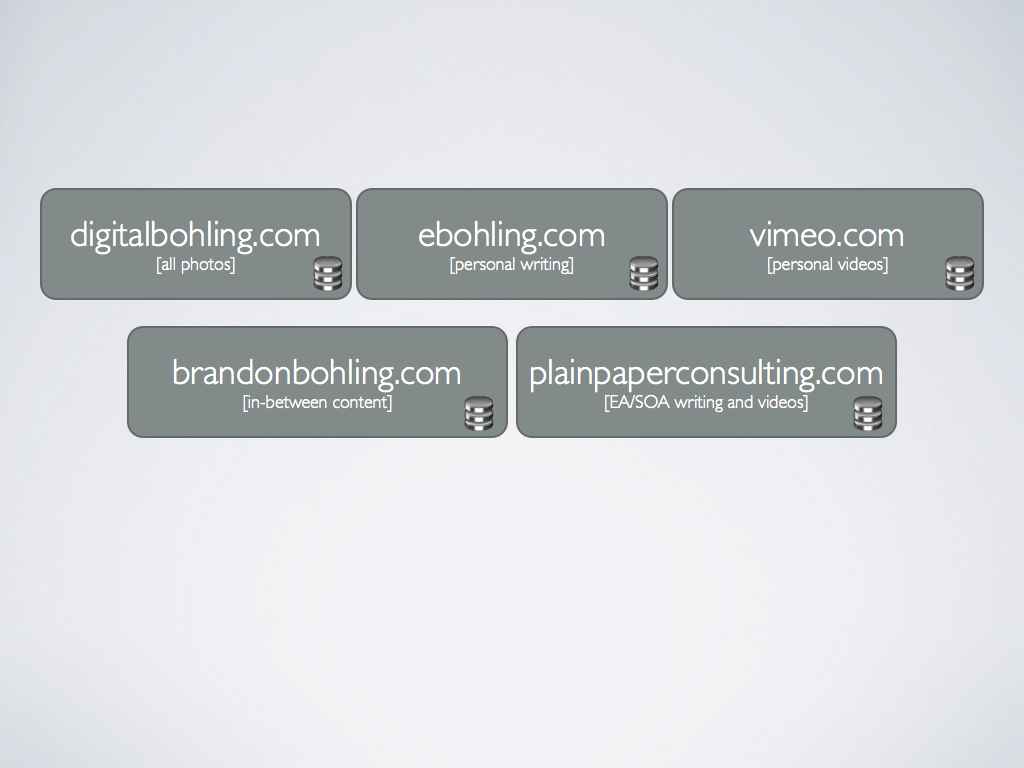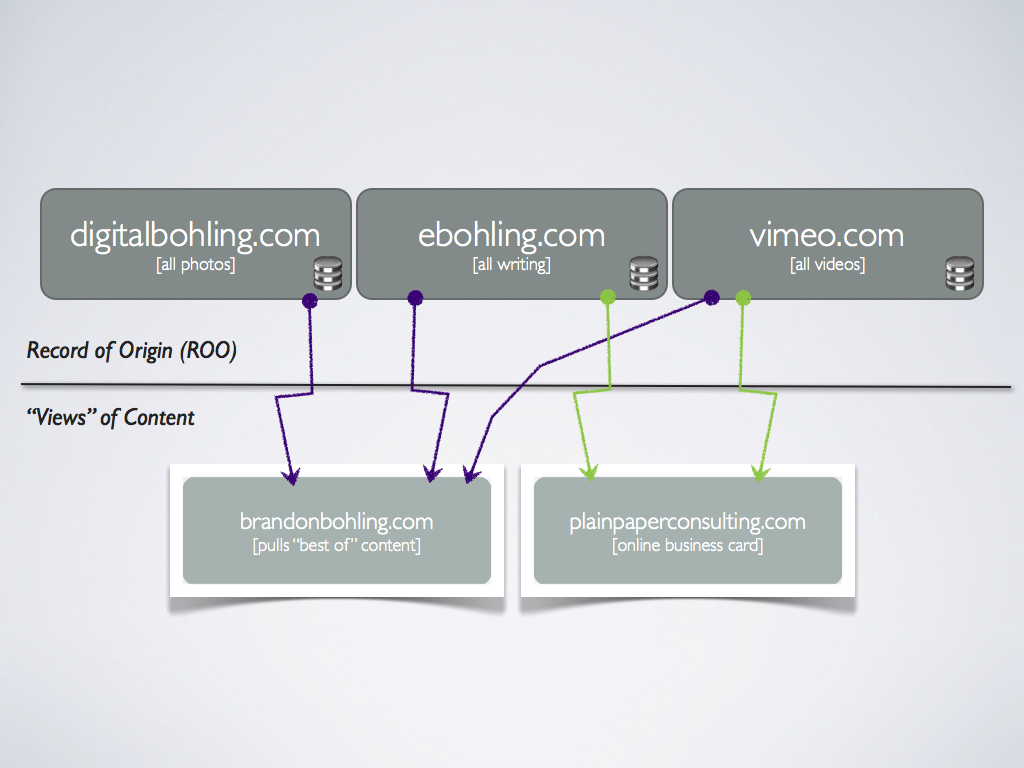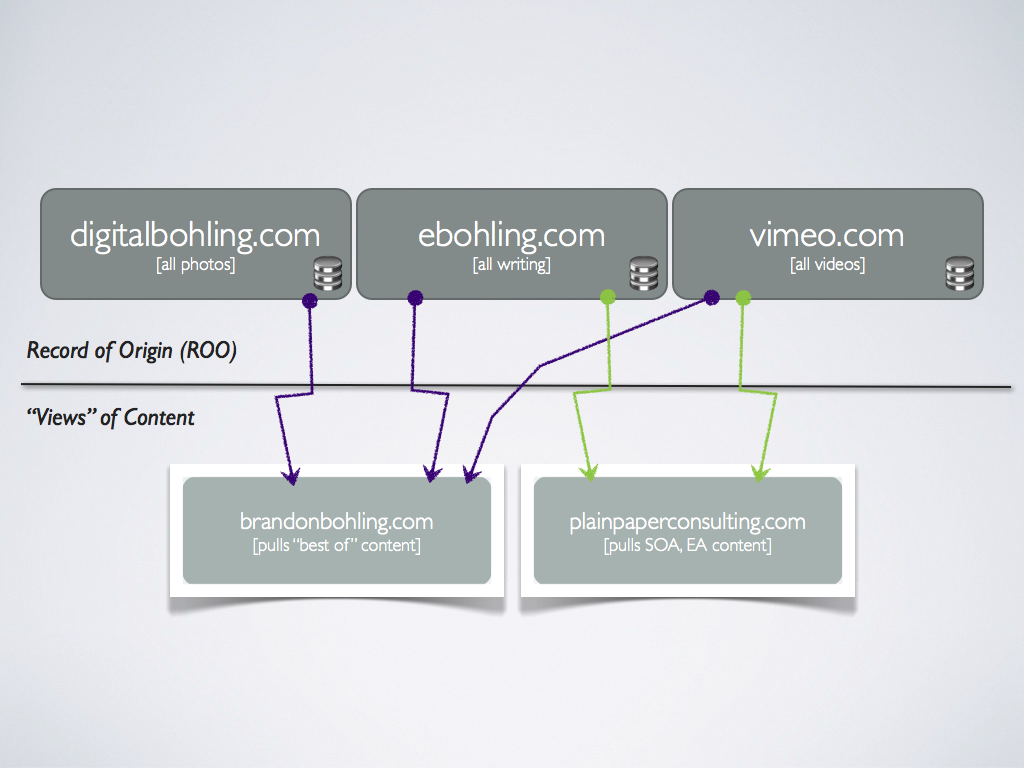Taking Control of Your Online Presence
I found this post I wrote back on June 10, 2012. I don’t believe I ever published it, but who knows since it feels like I’ve had more websites than content. Regardless, without any edits I think it still mostly applies today.
Professional vs. Personal Identities
A Brief History
It was in 1993 when I first connected to the Internet using a Mac FTP client Gopher, then shortly after that a Web browser called Mosaic. My email client was Elm, which was Unix-based. In 1995 I created my first website using only the basic HTML elements: Headers, Paragraph, and Hyperlinks. Now after developing hundreds of websites: simple static sites, e-commerce sites, portals, and content management systems, my online life is quite complex.
The Problem
How does one handle their online content including videos, photos, (micro)blogs, articles, etc.? As a developer, I feel obligated to custom build solutions. However, today there are so many hosted solutions like Flickr, YouTube, Vimeo, Blogger, Twitter, and many more. To add to the pile there are many self-hosted solutions: WordPress, PixelPost, Chyrp, SweetCron, etc. So what do you do?
To complicate the problem even further: handling personal content vs. professional content. Let’s walk through my situation to really define the problem.
My Personal Content
Like many people today, I want to share content with friends and family.
- Videos and Photos of our son, dog, spouse, travels, wine, food, and other interests.
- Writing regardless of format (blogs, tweets, tutorials, etc.) that only would interest friends and family.
My Professional Content
I currently own my own business, Plain Paper Consulting. The real money maker for my business is providing Enterprise Architecture (EA) consulting, which means a lot of Service Oriented Architecture (SOA) work at the moment. This means I could provide screencasts, tutorials, blogs on my business site that could establish my knowledge and experience.
The In-between Content
This is where it gets even more difficult. I have a lot of experience and knowledge in other areas such as photography, web design/development, information architecture, and technology in general. This content could be of interest to more than just friends and family; however, doesn’t really fit into Plain Paper Consulting’s core business model.
The Core Problems
- Where does all of my content live?
- How do I eliminate (reduce) duplication?
Possible Solutions
Of course there are many possible solutions to the problem statement and likely not a perfect solution. Below I will discuss some possibilities along with their strengths and weaknesses.
Separate Sites, Separate Content
The idea here is that each website will only host one type of content (professional vs. personal). With this solution the idea is to have each website have its own content.

Strenths
- Separate sites with relevant content
Weaknesses
- Managing content becomes cumbersome
- Extra effort is required to ensure each site has appropriate capabilities
- What happens to all that (still valid) content when Plain Paper Consulting no longer exist?
- What happens if I want content (the in-between content) to be on multiple sites?
- Required to point people to multiple websites depending on the content I want to showcase.
The Views Concept
Putting on my EA hat, another approach would be to have one record of origin (ROO) for each of my content types and then create views (separate websites) that pull (automatically) in the appropriate content. With this solution I would add content to three different websites (leverages their social network capabilities), but actually only market (promote) two sites. Business professionals are steered towards PlainPaperConsulting.com and all others are directed to BrandonBohling.com.

Strenths
- Separate sites, separate content without manual duplication (leverage ROO concept)
- Have specific sites for specific content, yet leverage the power of hosted, social network sites (vimeo, flickr/zenfolio)
Weaknesses
- Still have as many websites
- Need to create the content pull mechanism (existing capability, so really just a matter of configuring)
The Views Concept: One Step Further
Currently Plain Paper Consulting just happens to be a legal company that I use for accounting purposes. Tomorrow it could be another company name or I could even go back to being an employee, so it’s really just a façade. Therefore, one could argue that Brandon Bohling is my true professional identity. In this case, to further simplify content and website management, I could make PlainPaperConsulting.com a static site. Maybe just a few pages that discuss services offered, contact info, and client list.

Strengths
- Simplifies content and website management
- Still maintain a ROO
Weaknesses
- Not the best approach if I want to truly treat Plain Paper Consulting as a business.
Conclusion
One’s online presence is becoming a more mystifying challenge everyday, with more and more social network sites becoming available and people generating copious amounts of content. There are many ways to handle this problem, but none are perfect.
It is obvious though that this problem is not unique to me. Otherwise there wouldn’t be websites popping up almost daily to aggregate information. Sites like Tumblr, Yahoo Pipes, and FriendFeed to name just a few.
I believe, for me, it comes down to this: Brandon Bohling is my true professional identity. Currently Plain Paper Consulting just happens to be a legal company that I use for write-offs (to put it bluntly). Therefore one of the Views options will probably be the direction I take. Unfortunately, this is only the tip of the iceberg. After deciding on a direction, I must select the appropriate technologies to implement. Not to mention I completely ignored content from Twitter, which to date has no valuable content, but absolutely could; just look at this: 40 of the Best Twitter Brands and the People Behind Them. I guess another write-up will be in order soon.
Final Thought
Having gone through this process, I found it extremely interesting how similar it is to my role as an Enterprise Architect.